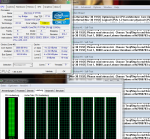Nur wenn du ganz lieb bitte bitte sagst

Spass beseite hier ein Auszug aus der PDF.
Das ist für Haswell.
1. Approximately 70% of CPUs can go up to 4.5GHz. Overall, most CPUs are capable of
reaching 44x to 45x with varying levels of voltage. Voltage will be a key item as it defines thermal
output. It is possible to run out of thermal headroom at lower frequencies due to a processor
requiring excessive voltage for stability.
2. Approximately 30% of CPUs can go up to 4.6GHz
3. Approximately 20% of CPUs can go up to 4.7GHz
4. Approximately 10% of CPUs can go up to 4.8GHz
Currently we are seeing voltage ranges between 1.150v to as much as 1.400 for similar/same
frequencies. An example would be 4.6GHz requiring 1.200 and another CPU requiring 1.400.
This is important as a the overall maximum load a single radiator single 120mm closed loop
cooling solution can dissipate under synthetic stress test load is approximately 1.250 to 1.275v.
This is assuming the ambient temperature is reasonable.
A voltage level of 1.350v or greater, is too high for enthusiast cooling solutions including water
cooling. With this in mind, maximum temperatures should be gauged by the use of real world
applications rather than synthetic stress tests.
Given Haswell’s thermal characteristics, pursuing per core overclocking can be beneficial as this
helps to maximize core frequency for various loading conditions.
Hier ist der Link zur PDF für Haswell :
http://forums.tweaktown.com/asus/52963-asus-haswell-i7-4770-near-final-overclocking-guide.html








